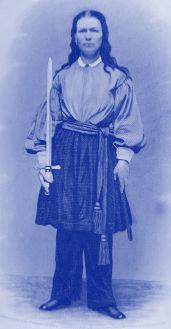La Fille du Régiment
GAETANO DONIZETTI

A STUDENT GUIDE
THE STORY
Many years before the story begins, after a battle, Sergeant Sulpice finds an infant girl with a letter from her father, Captain Robert, addressed to La Marquise de Berkenfeld. The Sergeant decides to raise the girl until he is able to find La Marquise. The girl's name is Marie and she becomes the adopted daughter of the 21st Regiment.
Act I: In a small village in the Swiss Tyrolean Mountains, local peasants prepare to fight the French troops. In the meantime, La Marquise, accompanied by her steward, Hortensius, is forced to take temporary refuge in the village while traveling home to her château. While the voice of Marie is heard singing a military tune, Sulpice enters the village and declares that the French would like to make peace. Marie has grown into a beautiful young woman, and all the men of the regiment take great pride in her. They have noticed, however, that she has been preoccupied lately. Marie confesses to Sulpice that she has fallen in love with Tonio, a young Tyrolese man who saved her life. Just then, the rest of the regiment arrives with a captive, who happens to be Tonio! The men accuse Tonio of being
a spy, not realizing that he is in fact in love with Marie and wandered into their camp looking for her. She vouches for his innocence, and he is forgiven. As the regiment marches away, Tonio sneaks back to see Marie, and they declare their love to one another.
Sulpice returns later to discover Tonio and Marie in an embrace, but they take no notice of him. When La Marquise approaches Sulpice to ask for an army escort back to her château, Sulpice recognizes her name. He mentions Captain Robert, and La Marquise nearly faints. She tells Sulpice that Captain Robert and her sister had a daughter. La Marquise was to be the girl's guardian at their death, but the baby girl was lost and may not even have lived. Sulpice joyfully exclaims that the girl is alive and was raised by his regiment. When Marie returns, Sulpice introduces her to her aunt, who wishes to take over guardianship of her niece. At first,
The C Characters
Marie: (Soprano) the adopted daughter of the 21st Regiment of Napoleon's Army
Tonio: (Tenor) a local Swiss boy who is in love with Marie
La Marquise: (Mezzo-Soprano) the Duchess of Berkenfeld
Sergeant Suplice: (Bass) a French Sergeant of the 21st Regiment of the Grand Army of Napoleon
Hortensius: (Bass) the steward of La Marquise
Corporal: (Baritone) one of Marie's many adopted fathers of the 21st Regiment
Duchess: (Soprano) the German Duchess of Krakenthorp who has a son of marrying age
when Sulpice explains that her father's dying wish was for her to live with her aunt, she agrees.
Having learned that the regiment will only allow Marie to marry one of their own, Tonio enlists. After much consideration, the regiment consents to their engagement. Sulpice breaks the news to the regiment that Marie has been reunited with her rightful guardian and is to leave that day. In a tearful parting, Tonio offers to accompany Marie when he is reminded that he has enlisted and therefore must stay with the regiment. Everyone bids Marie farewell.
Act II: At her château in Berkenfeld, La Marquise attempts to turn Marie into a refined young woman. She arranges an advantageous marriage for Marie to the Duke of Krakenthorp, which Marie refuses. Sulpice arrives at La Marquise's request to help convince Marie to marry the Duke. Marie reluctantly begins her voice lesson in order to practice the song she will sing to impress the Duchess, mother of the Duke. Sulpice watches Marie rehearse and enthusiastically interjects a bit of an old military tune Marie used to sing. In her excitement and nostalgia, Marie joins in. La Marquise scolds her for being so brash and unrefined.

Marie sadly resigns herself to the marriage arrangement and is consoled by Sulpice until suddenly she hears the (continued on next page)
The Story Continues
(continued from previous page) approach of the 21st Regiment! The entire regiment crowds into the room and Tonio takes Marie in his arms. La Marquise demands an explanation and Tonio professes his true love for Marie. La Marquise retorts that she has already been promised to another and bids the regiment farewell. Brokenhearted, Marie leaves the room, leaving La Marquise and Sulpice alone.
Overcome with emotion and past memories, La Marquise confesses to Sulpice her deepest secret: when she was a young woman, she was in love with an officer ranking below the aristocratic expectations of her family. They had a daughter together, but the affair was kept secret. The officer was
Captain Robert, meaning that Marie is not her niece, but her own daughter! If Marie marries the Duke, she will have a title and thus allow La Marquise to leave her the inheritance. Sulpice understands and agrees to help persuade Marie once again to accept to the arranged marriage.
The Duchess arrives and is ready to sign the marriage contract, but Marie is not present. Sulpice failed to persuade Marie to agree to the marriage without spilling La Marquise's secret. In tears of joy, Marie rushes into the room to embrace her newly discovered mother. She agrees to the marriage to please her mother and is just about to sign the contract when Tonio and the regiment burst in to rescue her. They exclaim, to the horror of the Duchess, that Marie is not a refined lady, but a daughter of the regiment. La Marquise relents, wishing happiness for her daughter above all, and allows Marie to choose her husband. Marie and Tonio embrace as they are allowed, at last, to wed. Everyone sings of the glory of France.
TIMELINE
1740
1760 A HISTORY LESSON
Donizetti was composing during a time of many pivotal historic events that have greatly influenced the world today. Study the timeline along the bottom of the pages of this guide of this period in history. Think about how these historical events influenced artists of the day and how they left behind reflections of the time in which they lived.
2
Social History † Music Art ✒ Literature 1700-1800 The Enlightenment † 1750-1820 Classical Period: Haydn, Schubert, Mozart, Beethoven 1765-1900 Romantic Period: Corot, Dela 1776 American Revolution 1789 French Revolution
COMPOSERAND LIBRETTISTS
The C Composer

Gaetano Donizetti was born in 1797 in Bergamo, Italy, just outside of Milan.
Musically gifted from an early age, Donizetti was accepted at age nine to study at the Lezioni Caritatevoli School where he met his mentor and the founder of the school, Simon Mayr. Mayr, whom Donizetti considered his second father, helped him with his studies and to launch a professional career. Donizetti was a prolific composer, writing more than 65 operas, as well as works for chamber orchestra, string quartets, and music for the church. He was highly influenced by his contemporary, Gioachino Rossini (Il barbiere di Siviglia), and imitated Rossini's work until he found his own style. Donizetti had a talent for composing very quickly and often completed an opera in as few as ten days. His most famous operas, two comedies and one drama, are L'elisir d'amore (1832), Don
Pasquale (1843), and Lucia di Lammermoor (1835) respectively. Although he was very fond of his home in Northern Italy, he spent many years living and composing in Paris, the cultural center of Europe at the time. The French culture had a large influence on his work, and La Fille du régiment (1840) was one of many operas he composed while living in Paris. He had a wife and three children, all of whom died from a cholera epidemic. Donizetti fell ill from complications of cerebro-spinal syphilis in 1845, and, after months of treatment in Paris, returned to his home in Italy, where he died in 1848.
The L Librettists
Georges Henri Vernoy de SaintGeorges (1799-1875) was a French dramatist who lived in Paris and wrote for vaudeville, theater, ballet, and opera. In 1829, he became the manager of l'Opéra-Comique in Paris and often commissioned work from Donizetti. He also published several novels. At least 50 of his pieces were written in collaboration with others, including Eugène Scribe, who was a well-known playwright and librettist. He collaborated with Jean-François Bayard (1801-1875) on La Fille du régiment, and it premiered at l'OpéraComique on February 11, 1840. Bayard was an intimate friend of Eugène Scribe. They often collaborated together and Bayard even married Scribe's niece. Like Saint-Georges, he was a prolific writer of drama and comedy who, alone or in collaboration, wrote for vaudeville, theater, ballet, and opera.

1780
roix, Rousseau, Millet, Courbet
1799-1815 Napoleonic Wars
† 1791 The Magic Flute, opera by Wolfgang Amadeus Mozart
Paris, France
For several centuries, Paris was the cultural and artistic capital of the Western world. Artists, whether painters, sculptors, musicians, writers, or dancers, moved to Paris to receive the best schooling and mentoring, to make a name for themselves, and be in the presence of other great artists. All aspired to gain international success and recognition, but few have become legendary.
1800
1804 Lewis and Clark embark on the exploration of the Western U.S.
† 1808 Symphony No. 5 by Ludwig van Beethoven
✒ 1813 Pride and Prejudice, novel by Jane Austen
† 1816 Il barbiere di Siviglia, opera by Gioachino Rossini

1820
† 1824 Symphony No. 9 by Ludwig van Beethoven
1830 Liberty Leading the People, painting by Eugène Delacroix
1836 l’Arc de Triomphe unveiled in Paris
✒ 1838 Oliver Twist, novel by Charles Dickens
3

Lady L Liberty
The concept of liberty is personified as a woman in both the United States and France. Marianne is the national emblem of France and appears on coins, stamps, and other national insignia. Her name dates back to before the French Revolution, when France was seeking an image of a populist country. Both Marie and Anne were common French names, and it was decided that the image of a strong woman would symbolize the “motherland” as a warrior, nurturer, and protector. French painter Eugène Delacroix depicted Marianne in his famous painting La Liberté guidant le people (1830). For the centennial celebration of the United States of America, in 1876, France created and gave Liberty Enlightening the World (commonly known as the Statue of Liberty) to the United States as a symbol of sisterhood between the two countries. Since then, it is widely regarded as a symbol of freedom for immigrants.

Social History
† Music Art
✒ Literature

1765-1900 Romantic Period: Corot, Delacroix, Rousseau, Millet, Courbet
† 1820 -1910 Romantic Period: Mendelssohn, Schumann, Liszt, Chopin, Beethoven, Tchaikovsky
1830s Industrial Revolution
† 1840 La Fille du régiment, opera by Gaetano Donizetti
✒ 1845 “The Tell-Tale Heart,” short story by Edgar Allan Poe
✒ 1847 Wuthering Heights, novel by Emily Brontë
From the ancient cultures to today, women have always played a role in war, even when it was not socially acceptable. Beginning in the 1650s, women supplied food and drink to the troops, washed laundry, and nursed the sick and wounded in the French army. During the Napoleonic wars, women took on a more defined role as vivandières or cantinières, which mean “hospitality giver” in French. Most often, these women were wives or daughters of high ranking officers. For this reason, young ladies were commonly referred to as la fille du régiment. At first, these women offered their services voluntarily, but, in 1865 in France, they were finally recognized and allowed decorations and compensation as official Vivandières of the military. They also took part in parades and marches. Vivandières wore similar uniforms to their male compatriots, but the pants were covered by a short wool skirt, often with feminine touches of lace or trim. Commonly distinguished by the casks containing spirits they carried over their shoulder to administer to the sick or wounded, vivandières played a variety of roles, including nurse, spy, mascot, cook, and laundress. They were widely respected by the men in their regiment and deeply valued for the nurturing role they played.
1860
1861-1865 American Civil War
† 1853 La traviata, opera by Giuseppe Verdi
✒ 1862 Les Misérables, novel by Victor Hugo
1872-1890s
1865 Assassination of President Abraham Lincoln
1871 Treaty of Versailles
1873 Impression, Sunrise, painting by Claude Monet
1840
4
TIMELINE
WOMENINTH
HE MILITARY

Vivandières also played a prominent role in the American Civil War. Many of the militia adopted the Napoleonic style of military formation, uniform, and strategy, because Napoleon's army was regarded as very strong and successful. Vivandières in the United States were similar to the ones in France, with the exception that they occasionally carried weapons for self defense. Their most common and most prominent role, however, was
that of a nurse. Some areas held “dress parades,” where the local village girls put on their finest dresses and walked through the center of town for the militia men to elect a “daughter of the regiment.”
From that point onward, women have continued to have an active role in the military. Women contributed significantly to World War I by entering the workforce and
taking over many jobs traditionally occupied by men while the men were at war. They also served as medically trained nurses. Participation increased in World War II, as women worked in munitions factories and built war implements, in addition to serving on the front lines as nurses. Only in the last 50 years have women gained equal footing with men in being eligible to perform most of the same duties in war. There is still, however, much controversy over this issue.
Humor a as T Therapy
Topics of war, which are often difficult to address openly within society, can be effectively discussed using humor expressed through the arts. It is a delicate job to create a light-hearted, funny, or ironic piece about war without being offensive; however, many skilled artists have mastered this balance. La Fille du régiment was originally set during the Napoleonic Wars, but the opera premiered 25 years after they ended. Those who filled the opera house at the premiere had lived through the horrors of war and remembered them well. Some more modern examples of using humor to talk about war include the musical South Pacific, the films Good Morning Vietnam and Life is Beautiful, and the T.V. show M.A.S.H. Comedians such as the Marx Brothers, Charlie Chaplin, and the Monty Python crew have also addressed the subject of war.
1880
Impressionism: Pissarro, Manet, Degas, Monet, Renoir


1900
1890s-1905 Post-Impressionism
1879 The Little Dancer of Fourteen Years, sculpture by Edgar Degas
1879 Thomas Edison perfected the electric light bulb
1914-1918 WWI
1887 The Kiss, sculpture by Auguste Rodin †
1892 The Nutcracker, ballet by Peter Ilyich Tchaikovsky
1920
5
Kady Brownell of the 1st (later 5th) Rhode Island, as depicted in Frank C. Moore, Women of the Civil War, 1866.
BEL CANTO & OPÉRA COMIQUE
La Fille du régiment is one of the few operas that fits into the categories of both bel canto and opéra comique.
Reaching the height of its popularity in the 18th century, bel canto (Italian for “beautiful singing”) is characterized by music that showcases the voice. Composers such as Vincenzo Bellini
(Norma), Gioachino Rossini (Il barbiere di Siviglia), and Gaetano
Donizetti are well known for writing operas and art songs in this style. It was common, and even expected, for the singer to add improvised embellishments between the notes already written. These embellishments are referred to as coloratura.Bel canto can be distinguished by smooth, delicate, slow singing or fiery fast singing that ranges the entire scale.
there are movie theaters. This is what it was like in Western Europe from the 17th century to the 20th century. Almost everyone attended the opera regularly, and audiences were harsh critics. They would throw rotten fruit if they didn't like it, and cheer “Bravo!” and “Encore!” if they did.
Vocal Acrobatics
People who come to hear a bel canto opera are not only expecting to hear “beautiful singing,” but something more as well. Singers love to show off their vocal abilities, and composers often write an opera to show off a specific singer's voice.
Singing high notes are particularly challenging and just one of the many “vocally acrobatic” stunts a singer can perform. In the case of this opera, while Donizetti gave some beautiful coloratura passages to the soprano (Marie), he gives the heroic tenor (Tonio) nine high “Cs” (a very high note for a tenor to sing) in one aria! See if you can count them.
Opéra comique is a French term for an opera that has spoken dialogue between arias. Although the term originated to describe operas of lighter subject matter, by the late 18th century, subjects from the drame bourgeois (working-class drama) were popular. One of the most recognized operas of the opéra comique genre is George Bizet's Carmen. Later on, opéra comique evolved into the operetta, which is a short, light opera including spoken dialogue and dances. This mix of spoken dialogue and music was not popular in Italy, and all Italian opera was sung throughout. When Donizetti later adapted La Fille du régiment for Italian audiences, he changed the dialogue to recitative, or dialogue that is sung.
During the mid-1800s, opera was considered a form of popular entertainment rather than “high art.” Hundreds of operas were written each year by many different composers, but few had lasting value, which is why only a few are known today. Imagine if there were as many opera houses in America as
How could composers create fulllength operas so quickly to satisfy public demand? Bel canto followed specific unwritten rules within which each opera could be composed. Donizetti and his contemporaries were masters at following this formula and could write a new opera in a matter of weeks or even days! This unwritten formula was common knowledge among opera composers and librettists of the time. They knew the kind of stories that were appropriate for the plot, how many characters there should be, what voice types should be included, and how much each voice type was supposed to sing. They were also familiar with certain rhythms that the orchestra should be playing during different moments of the opera. These conventions made it very easy for a composer to meet with a librettist and the opera house manager, map out an outline for a new opera, and have it open in a short amount of time. The music seemed almost recognizable as a result of this common formula and also because composers often borrowed from popular music of the day. This not only made it easy for the singers to learn but also for the audience to remember. It was not uncommon to hear people humming tunes from the latest opera as they went about their day.
6
ATTHE OPERA HOUSE
You will see a full dress rehearsal, an opportunity to get an insider's look into the final moments of preparation before an opera opens. The singers will be in full costume and makeup, the opera will be fully staged, and a full orchestra will accompany the singers, however they may choose to mark, or not sing full voice, in order to save their voices for the performances. A final dress rehearsal is often a complete
Please respect other patrons’ enjoyment by not leaning forward in your seat so as to block the person’s view behind you, and by turning off cell phones, pagers, watch alarms, and other electronic devices that make noise.
At the very beginning of the opera, the concertmasterof the orchestra will ask the oboe player to
Taking photos or making audio or video recordings during a performance is not allowed.
Let the action on stage surround you. As an audience member, you are a very important part of the process that is taking place. Without you, there is no show!
Read the English supertitles


7
Credits
Writer: Rebecca Kirk
EDUCATIONAND COMMUNITY PROGRAMS
AREMADEPOSSIBLEBYTHEFOLLOWINGFUNDERS:
$50,000 and above
Mr. and Mrs. John Pohanka
$25,000 and above
The Bank of America Charitable Foundation
$15,000 and above
DC Commission on the Arts and Humanities and the National Endowment for the Arts

John and Cora H. Davis Foundation
$10,000 and above
Clark-Winchcole Foundation
Philip L. Graham Fund
Jacob & Charlotte Lehrman Foundation
The Honorable and Mrs. Jan M. Lodal
Prince Charitable Trusts
The Washington Post Company
$5,000 and above
Theodore H. Barth Foundation
International Humanities
$2,500 and above
Mr. Walter Arnheim
The Max and Victoria Dreyfus Foundation Target
The K.P. and Phoebe Tsolainos Foundation
$1,000 and above
Dr. and Mrs. Ricardo Ernst
Justice Ruth Bader Ginsburg and Professor Martin Ginsburg
Horwitz Family Fund
Education and Community Programs Associate
Graphic Design:
Suzan L. Reed
Suzan Reed Graphics

Founded in 1956, Washington National Opera is recognized as one of the leading opera companies in the United States. Under the leadership of General Director Plácido Domingo, Washington National Opera continues to build on its rich history by maintaining consistently high artistic standards and balancing popular grand opera with new or less frequently performed works.
As part of the Center for Education and Training at Washington National Opera, Education and Community Programs provides a wide array of programs to serve a diverse local and national audience of all ages. Our school-based programs offer students the opportunity to experience opera through in-depth, yearlong school partnerships: the acclaimed Opera LookIn, the District of Columbia Public Schools Partnership, and the Kids Create Opera Partners (for elementary schools), and the Student Dress Rehearsal (for high schools) programs. Opera novices and aficionados of all ages have the opportunity to learn about the season through the Opera Insights series, presented on the Kennedy Center Millennium Stage. All Insights are free, open to the pubic, and archived on the WNO website. Outreach to the greater Washington D.C. community is achieved through our public Library Program, the Family LookIn,and the Girl Scout Program. Our summer training programs give youth age 10-18 an opportunity to experience firsthand what goes into an opera performance through Opera Camp for Kids, which culminates in WNO’s Family Opera, and Opera Institute for Young Singers.
Editors:
Michelle Krisel
Director, Center for Education and Training
Caryn Fraim
Associate Director, Education and Community Programs
Stephanie Wright
Education and Community Programs Manager
Hannah Grove-DeJarnett Communications Coordinator
For more information on the programs offered by Washington National Opera, please visit our website at www.dc-opera.org















